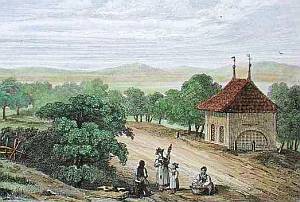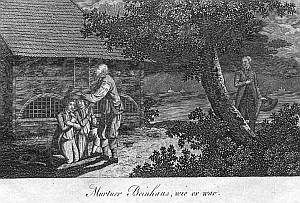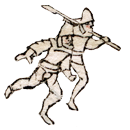History > The Battle of Morat 1476
The Fate of the Morat Ossuary
 Visitors to the battlefield of Morat might find it odd that its main monument, a stone obelisk, if they manage to locate it at all [LOC], stands well to the south-west of the actual battlefield. One might have assumed that the battle monument would be located in a more prominent place such Charles the Bold's headquarters atop Bois Domingue. The obelisk owes its location to the fact that it replaced the Morat ossuary destroyed by the French invaders in 1798.
Visitors to the battlefield of Morat might find it odd that its main monument, a stone obelisk, if they manage to locate it at all [LOC], stands well to the south-west of the actual battlefield. One might have assumed that the battle monument would be located in a more prominent place such Charles the Bold's headquarters atop Bois Domingue. The obelisk owes its location to the fact that it replaced the Morat ossuary destroyed by the French invaders in 1798.
The Morat ossuary in turn was situated there in proximity of the mass grave of the slain Burgundian soldiers trapped between Lake Morat and the Swiss forces. The Swiss terror policy of taking no prisoners led to a massacre. The Swiss only spared women (who had to endure the humiliation of proving their sex by exposing their private parts: "jr Schämen und Brüst entdecken und erzeigen mußtent"). The Burgundian soldiers drowned in the lake or were mercilessly killed. The chronicler Diebold Schilling writes:
"und kam auch semlich gros Angst und Not unter sie, das gar vil von rechtem Jammer und Schrecken in den Murten-See ritten und loufen mußten, das er von der Statt Murten, bis oben us an das Moos, da er ein Ende hat, aller voll Lühten stund und lag, die alle darinne erstochen und erschlagen wurden, Und sich auch selber von rechter Angst und Not mußten ertrencken, was die niemand mocht zehlen noch überschlagen von Menge der Lüchen, und warent merenteils alles Lamparter, dann dieselben jr Leger by dir Statt unter den Nußböwmen neben dem See hatten." (Schilling, vol. II, p. 49) [EN]
"Also wurdent die von Bern von stund an zu rat, das man die toten libe, so dennocht in dem velde und in dem sewe unvergraben warent, als vil man dero vinden mocht, suchen und vergraben und wurden lute darzuo geordnet, die das tun solten. Also wurden der toten luten funden und zesamengetragen us dem wasser und uf dem velde, die dann vergraben wurden." (Schilling, vol. II, p. 60) [EN]
In 1485, a chapel was dedicated in which the exhumed bones from the mass graves were collected, a project originally started in 1481. In 1506 Berne and Fribourg paid for a proper ossuary building which was consecrated by the bishop of Lausanne in 1514. The oldest inscription in marble on the north side read:
Valeant qui vafrum campo pellere hostem. Agressi Karolum, Burgundie lumen superbum. Celicolas cantu martisque onerent aras Victima dulci, armorum qui novere vires. Annorum fluxu milleno quadringenoque Junctis septuagintaque, atlas volveret ac Sexta, acta Martyrum mille denorum Luce, quos trux stracerat hostium ensis. (quoted in Reichlen, p.108) [EN]In 1560, the coat of arms of Fribourg was installed. In 1564, the following (relatively neutral) inscription was added in bronze (the French later carried off this tablet and only restored a copy to Fribourg):
Dies Gebein ist der Burgunder SchaarIn 1581, a protective iron grill was added. Finally, works on the road to Lausanne in 1755 triggered a full scale renovation. Two further texts were added to the ossuary. The first one was administrative:
Im vierzehn hundert sieben und sechsten Jahr
Vor Murten duch Eidgnosschaft
Erlegt mit Beystand Gottes-Kraft
Auf der zehntausend Ritter-Tag
Geschah diese grosse Niederlag
Meister Peter von Buren goss mich 1564.
deo optim max
Caroli incliti et fortissimi
Burgundiae ducis exercitus
Muratum obsidens ab
Helvetiis caesus hoc
sui monumentum reliquit.
anno m.cccc.lxxvi. (quoted in Reichlen, p.109) [EN]
Sacellum quo reliquiasThe second inscription by noted Bernese Enlightenment anatomist, naturalist and poet Albrecht von Haller is a patriotic exhortation verging on chauvinism by its anti-French tone:
exercitus burgundiae ab helvetiis, a. 1476,
pia antiquitas condidit.
renovari viisque publicis muniri
jusserunt rerum nunc dominae
republicae Bernensis et friburgensis
anno 1755. (quoted in Reichlen, p.110) [EN]
Steh still Helvetier! hier liegt dass kühne Heer,
Vor welchem Lüttich fiel, und Frankreichs Thron erbebte,
Nicht unser Ahnen Zahl, nicht künstliches Gewehr,
Die Eintracht schlug den Feind, die ihren Arm belebte.
Kennt Brüder Eure Macht; sie liegt in Eurer Treu,
O würde sie noch ietz bei iedem Leser neu! [EN]
In sum, though, the ossuary was a dignified commemoration of the battle's fallen that shouldn't have triggered any retribution nor its senseless destruction.
Napoleon Bonaparte's Tribute
 In 1797, Napoleon Bonaparte, victorious in Italy, having just concluded the treaty of Campo Formio which ended the First Coaltion, stopped at the Morat ossuary on his way to the Congress of Rastadt to discuss the French annexation of the German territories on the left bank of the Rhine. Napoleon quipped to a young officer:
In 1797, Napoleon Bonaparte, victorious in Italy, having just concluded the treaty of Campo Formio which ended the First Coaltion, stopped at the Morat ossuary on his way to the Congress of Rastadt to discuss the French annexation of the German territories on the left bank of the Rhine. Napoleon quipped to a young officer:
"Rappelez-vous, jeune capitaine, que si jamais nous livrons bataille en ces lieux, nous ne prendrons pas le lac pour retraite." (quoted in Aubertin, p.9) [EN]
Napoleon's most famous victory at Austerlitz in 1805 would indeed push his opponents into the Satschan ponds. Napoleon was among the ossuary's last visitors as the invading French army in 1798 destroyed it.
While Napoleon started to conquer Egypt in 1798, two small French armies set out for Switzerland to liberate/annex the French-speaking parts, gain control of the important Alpine passes and to extract funds from the Swiss cities to finance the costly wars of the French government.
The French were greated as liberators by the Francophones of Valais and Vaud, whose Savoyard territories had been conquered and annexed by the German-speaking invaders in the wake of the Burgundian Wars in 1476/1536 and 1538 respectively. After an intermezzo as the Lemanic Republic, Vaud would choose "liberté et patrie" as its motto when it finally became an independent Swiss canton in 1803. [cont.]
The Destruction of the Morat Ossuary
In January 1797, Vaud declared its independence and was occupied by 12.500 men in five demi-brigades under General Guillaume Marie Anne Brune. Another 17.500 men French army of seven demi-brigades under General Alexis Balthazar Henri Schauenburg approached from the direction of Basel. Berne placed its first division at Morat under the overall command of Karl Ludwig von Erlach, its second at Büren an der Aare while the smaller third division kept watch towards Aargau.
In contrast to the Confederate assistance during the Burgundian Wars, the Confederates dragged their feet. Berne had to fight this invasion alone, reluctantly. In a drôle de guerre, Berne vacillated between defense and surrender. While Schauenburg finally advanced, pushing the weak resistance out of the way, Berne itself withdrew its division from Morat during the night of the second of March 1798. On the third of March 1798, French troops occupied Morat which set the stage for the destruction of the ossuary.
![Das Beinhaus oder die Capelle darin[n] der in der Murter Schlacht umgekom[m]ene Burgundiern Gebein aufbehalten werden, gegen Norden anzusehe[n], Neue und vollständige Topographie der Eidgenossenschaft, D. Herrliberger, 1755](Beinhaus_Murten_printing_1755s.jpg) While the majority of the French troops was not interested in the ossuary, Burgundian musicians from the 75th demi-brigade sought to erase the memory of the defeat by first trying to burn the bones in the ossuary. Having failed in their task, they next tried to blow up the ossuary. The well-built ossuary defeated them again, only the tiles fell from the roof. They might have given up, if not for a local hothead called Junot from the village of Bonvillars, located near Charles the Bold's other battlefield of Grandson. Junot asked the local commander for permission to level the building. His wish was granted and the ghastly deed done. The Official Bulletin of the People of Vaud celebrated the act in its issue 45, 21st March 1798 as follows:
While the majority of the French troops was not interested in the ossuary, Burgundian musicians from the 75th demi-brigade sought to erase the memory of the defeat by first trying to burn the bones in the ossuary. Having failed in their task, they next tried to blow up the ossuary. The well-built ossuary defeated them again, only the tiles fell from the roof. They might have given up, if not for a local hothead called Junot from the village of Bonvillars, located near Charles the Bold's other battlefield of Grandson. Junot asked the local commander for permission to level the building. His wish was granted and the ghastly deed done. The Official Bulletin of the People of Vaud celebrated the act in its issue 45, 21st March 1798 as follows:
"Les Français sont ici la victoire avec eux. L'ossuaire de Morat est en cendre. Ce féroce et execrable monument n'affligera plus l'humanité par de penibles Souvenirs. II brûle en ce moment au milieu des danses et des chants, qu'anime la musique guerrière." (quoted in Reichlen, p.82) [EN]The Parisian Moniteur Universel gloated on the 16th of March 1798:
"Ils (les Bernois) avaient retranché la fameuse chapelle de Morat, espérant y renouveler la scène des Bourguignons. Les Français républicains ont donné les honneurs du bûcher aux ossements de ce mélange d'étrangers et de Bourguignons, conduits en Suisse, il y a 310 ans, par Charles le Téméraire; l'arbre de la Liberté a été planté sur leur tombeau le jour de l'anniversaire de l'ancienne bataille de Morat (sic)." (quoted in Reichlen, p.82) [EN]
The destruction and plunder continued in the city of Morat itself where Bernese signs, images and coat of arms were vandalised. On the fourth of March 1798, Brune himself entered Morat. The next day, he clashed with the Bernese forces at the battle of Neuenegg. Brune's defeat didn't matter as Schauenburg's victory the same day at the battle of Grauholz decided the issue. Berne capitulated. The French had won and both the Morat ossuary and Berne's Ancien Régime were ruined.
Lord Byron's Morat Bones
The ruins of the Morat ossuary and the exposed bones were seen by another famous visitor to the battlefield: Lord Byron who paid a visit on his way from Basel to Lake Geneva in 1816. The ghastly view of the remains found its expression in Canto III of Childe Harold's Pilgrimage, stanzas 63 and 64, linking the battle to both the classic´past of Marathon and Cannae as well as the slaughter of the recent present at Waterloo:
But ere these matchless heights I dare to scan,
There is a spot should not be pass'd in vain, -
Morat! the proud, the patriot field! where man
May gaze on ghastly trophies of the slain,
Nor blush for those who conquered on that plain;
Here Burgundy bequeath'd his tombless host,
A bony heap, through ages to remain,
Themselves their monument; - the Stygian coast
Unsepulchred they roam'd, and shriek'd each wandering ghost.
While Waterloo with Cannae's carnage vies,
Morat and Marathon twin names shall stand;
They were true Glory's stainless victories,
Won by the unambitious heart and hand
Of a proud, brotherly, and civic band,
All unbought champions in no princely cause
Of vice-entail'd Corruption; they no land
Doom'd to bewail the blasphemy of laws
Making kings' rights divine, by some Draconic clause.
The quartett of Darius (Marathon), Hannibal (Cannae), Charles the Bold (Morat) and Napoleon (Waterloo) does not fully fit, as the "bad" guy won at Cannae, necessitating Byron's twist about the Ozymandian despair in the presence of such carnage which quickly shifts to a morbid fascination to acquire and treasure some of the remains:
"The chapel is destroyed, and the pyramid of bones diminished to a small number by the Burgundian Legion in the service of France; who anxiously effaced this record of their ancestors' less successful invasions. A few still remain, notwithstanding the pains taken by the Burgundians for ages (all who passed that way removing a bone to their own country), and the less justifiable larcenies of the Swiss postilions, who carried them off to sell for knife-handles; a purpose for which the whiteness imbibed by the bleaching of years had rendered them in great request. Of these relics I ventured to bring away as much as may have made a quarter of a hero, for which the sole excuse is, that if I had not, the next passer-by might have perverted them to worse uses than the careful preservation which I intend for them." (The Works of Lord Byron, vol. 2, p. 171)
Lord Byron sent the bones of a "quarter of a hero" on to his publisher John Murray. A footnote in the collected works of Lord Byron remarks that "Mr. Murray still has in his possession the parcel of bones." Virginia Murray of the John Murray Archive mentions in her 2007 talk at the National Library of Scotland that the Victoria and Albert Museum exhibition about Lord Byron in 1974 "included Byron letters, manuscripts, printed books, works of art, clothing, boots and bones, and all sorts of memorabilia, including lots of hanks of hair!" So in all probability, the Morat bones are still in existence. I have ordered the exhibition catalog to check whether they are listed therein. I will also contact the John Murray Archive.
A few years after Lord Byron's visit, in 1822/23, Fribourg and Switzerland finally tidied up the place. After a few failed attempts in 1819 (never executed) and 1820 (ugly stone), the obelisk that is presently still in its place was installed with the following bland description:
Victoriam
XXII Jun. MCCCCLXXVI
Patrum Concordia
Partam
Novo Signat Lapide
Republica Friburg.
MDCCCXXII.
Sources
- Charles Aubertin: Quelques renseignements sur l'ossuaire des Bourguignons à Morat, 16p., impr. de A. Batault, Beaune 1882.
- George Gordon Byron: The Works of Lord Byron, Vol. 2, John Murray, 1904.
- Florens Deuchler: Murten Bild einer Stadt, Rosepierre, Genève 1975.
- Theodor de Quervain: Wie Albrecht Hallers Inschrift am Beinhaus in Murten entstanden ist, Berner Zeitschrift für Geschichte und Heimatkunde (1950:3), p.163-164.
- Fr. Reichlen: L'ossuaire, l'obélisque et la chapelle de Saint-Urbain de Morat, Revue historique vaudoise, vol. 15 (1907), p.76-82, 108-115.
- Jürg Stüssi-Lauterburg: Vivat das Bernerbiet bis an d'r Welt ihr End!, Historischer Verein des Kantons Bern, Bern 2000, ISBN 3856480897.
- Gustav Tobler (ed.): Die Berner-Chronik des Diebold Schilling, Im Auftrag des historischen Vereins des Kantons Bern, herausgegeben von Gustav Tobler, Bern 1897-1901. Digitale Ausgabe 2006.
Written by Jean-Claude Brunner, December 2011.

